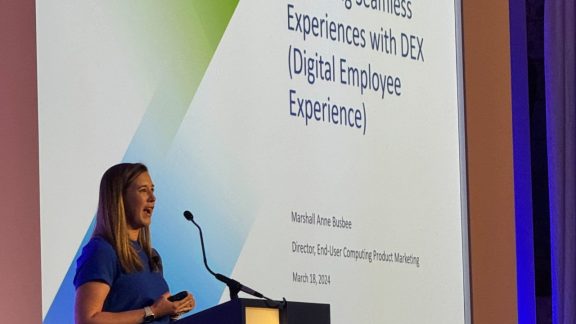By Fred Schimscheimer, Sr. Technical Marketing Manager, End-User Computing
Performance does matter! And don’t let anyone tell you otherwise. Have you seen the report by Principled Technologies comparing VMware View 5 to Citrix XenDesktop 5.5 from a display protocol perspective? http://www.vmware.com/files/pdf/techpaper/PCoIPvHDXsinglesession03-05-12.pdf. Principled Technologies discovered that the default protocol configurations were different in the two products and when adjusted to match each other, VMware View 5 was equal to or superior to XenDesktop 5.5 in several key performance areas. This report provides an accurate side-by-side comparison of VMware’s PCoIP and Citrix’s HDX display protocols along with a detailed explanation of lossless and lossy compression.
I want to point out that both products are not configured the same by default. VMware View 5 defaults to 30 frames per second and has build to full lossless compression enabled. Citrix XenDesktop defaults to 24 frames per second and ‘normal quality’, i.e., lossy compression. So what did Principled Technologies do? They ran two sets of tests. In one test they configured the PCoIP settings to match the HDX lossy default settings and in a second test they configured the HDX settings to match the PCoIP default lossless settings. In other words, they configured one display protocol to match the other, making it as close as possible for an apples-to-apples comparison. Take a look at the images (both color and black and white) of various portions of the screen captures. This is a great way for you to see for yourself and do your own comparison. My eyes tell me that PCoIP looks just as good if not better than HDX!
Are looks everything? No! Just take a look at the charts. You’ll see that VMware View 5 has equal or better efficiency in bandwidth consumption as well as client and server side CPU utilization when compared to Citrix XenDesktop 5.5 on common office applications.
One word of caution you’ll want to note. XenDesktop did do better in one use case where Flash Redirection was used for a Flash movie trailer. However, XenDesktop only did better in average bandwidth consumed and only slightly better in CPU utilization. You’ll note in the charts that where Flash Redirection was not used or was disabled, View 5 did much better. Even if XenDesktop did do better than View 5, everything had to be just right to work. You need a rich client capable of rendering the media. The content also had to be accessible by both the client and the VM. Both the client and VM must have supported browsers like Internet Explorer and compliant versions of Adobe Flash Player installed. It was noted that if any one of these components is not compatible or functioning, the system would fail back to server-side rendering. Citrix also has a troubleshooting guide to help you when you have problems with Flash Redirection which is located at http://support.citrix.com/article/ctx127188. This is not something I’d like to be troubleshooting and for just one use case where Citrix is better, really only slightly better. It just isn’t worth it.
Here is one more thing that isn’t worth it. Security. We all want to be as secure as possible, so in light of the one use case where XenDesktop performs better, they actually have security risks and have highlighted this on their support site with ‘Caution: Flash Redirection requires significant interaction between the user device and server components. Therefore, this feature should be used only in environments where security separation between the user device and server is not needed. User devices should be configured to use the Flash Redirection feature only with trusted servers. Flash Redirection requires the Flash Player to be installed on the user device. Therefore, Flash Redirection should be enabled only if the Flash Player itself is secured.’ See for yourself, the warning is located here: http://support.citrix.com/proddocs/topic/xendesktop-als/hd-flash-wrapper-ad.html.
My money is on VMware View 5 with PCoIP. The reduction in bandwidth and CPU across a wide variety of workloads means that View-based virtual desktops can achieve greater density, which can result in cost savings for an organization.
Oh, but there is one more question that you want answered. Why was this testing done on a LAN and not a WAN? Am I correct? Well, there is more to come. We wanted to establish a watermark/benchmark to compare against in our future tests. So stay tuned. We’re not done yet!






